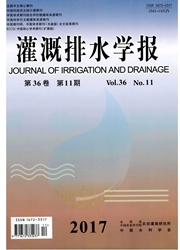

 中文摘要:
中文摘要:
通过不同水源组的试验,探索了室内引黄滴灌系统灌水器堵塞的过程及诱发机理。结果表明。灌水器平均相对流量和流量偏差系数均随着系统运行而呈先波动平衡后线性变化的趋势(R^2〉0.81)。黄河水滴灌灌水器比常规高含沙水源滴灌、地下水滴灌更易发生堵塞,平均相对流量分别低5.51%土3.07%和29.50%土4.16%,其线性递减斜率分别高15.3l%和194.51%,而流量偏差系数分别高0.11±0.04和0.26土0.07。黄河泥沙颗粒物仍是诱发灌水器堵塞的主要因素,但黄河泥沙表面附生生物膜的存在会显著加深灌水器整体堵塞程度。确定引黄滴灌系统灌水器堵塞控制策略时,应从物理、化学、微生物等多途径予以解决。
 英文摘要:
英文摘要:
Through indoor drip emitter clogging experiment, the process and inducing mechanism of emitter clogging were explored. The results indicated that both Dra and Cv of drip irrigation system using Yellow River water changed linearly (R^2〉0.81) after initial fluctuation balance. Emitters in OYRW treatment were easier to be clogged than those in GHSW and GW treatments. Dra were 5. 51%±3. 07%and 29.50%±4. 16% lower, and descending slopes of Dra in the linear phase were 15. 31% and 194. 51% higher, respectively. Meanwhile, Cv were 0.11±0.04 and 0.26±0.07 higher, respectively. Solid particles in Yellow River water were still the major factor inducing drip emitter clogging. However, in coexisting system like Yellow River water, the attachment of biofilms on the surface of solid particles would significantly increase the entire clogging degree of drip irrigation emitters. Therefore, an integrated strategy should be considered to control emitter clogging from the physical, chemical and microbiological means.
 同期刊论文项目
同期刊论文项目
 同项目期刊论文
同项目期刊论文
 Eight emitters clogging characteristics and its suitability evaluation under on-site reclaimed water
Eight emitters clogging characteristics and its suitability evaluation under on-site reclaimed water Effects of lateral flushing on emitter clogging and biofilm components in drip irrigation systems wi
Effects of lateral flushing on emitter clogging and biofilm components in drip irrigation systems wi Characterizing the dynamic microbial community in drip irrigation emitters and its effects on bio-cl
Characterizing the dynamic microbial community in drip irrigation emitters and its effects on bio-cl Eight emitters clogging characteristics and its suitability under on-site reclaimed water drip irrig
Eight emitters clogging characteristics and its suitability under on-site reclaimed water drip irrig Effects of flow path depth on emitter clogging and surface topographical characteristics of biofilms
Effects of flow path depth on emitter clogging and surface topographical characteristics of biofilms Preliminary surface topographical characteristics of biofilms attached on drip irrigation emitters u
Preliminary surface topographical characteristics of biofilms attached on drip irrigation emitters u ANALYSIS OF TRACING ABILITY OF DIFFERENT SIZED PARTICLES IN DRIP IRRIGATION EMITTERS WITH COMPUTATIO
ANALYSIS OF TRACING ABILITY OF DIFFERENT SIZED PARTICLES IN DRIP IRRIGATION EMITTERS WITH COMPUTATIO 期刊信息
期刊信息
